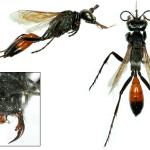This is one of the six British species retained within the family Sphecidae, whilst the remainder of the digger wasps are placed within the Crabronidae. It is closely related to P. hirsuta (Scopoli).
In the British Isles, recorded only from the Channel Islands.
Globally, it is found across central Europe, from France, through Germany, eastwards to Kazakhstan, with a few localities in Denmark and Sweden (Lomholdt, 1984).
The Channel Islands are, for a number of reasons, excluded from the geographical coverage of the British Red Data book (Shirt, 1987) and the subsequent review (Falk, 1991).
Lomholdt (1984) suggests that this species appears to prefer areas of sand-drift in coastal localities, primarily along the Atlantic seaboard, the North Sea and parts of the Baltic. However, its presence in Austria, Slovakia and Hungary indicates that this association is not obligatory.
No data available for the British Isles. Dollfuss (1991) gives June to September for European records.
No data available. Related species prey on the larvae of noctuid moths.
No data available, beyond the apparent association with loose sand.
No data available for the British Isles. Bitsch et al. (1997) note the species being seen at flowers of thrift and sea holly.
No data available.


